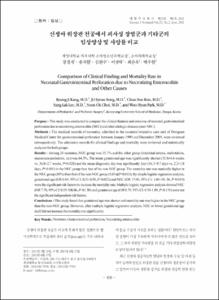신생아 위장관 천공에서 괴사성 장염군과 기타군의 임상양상 및 사망률 비교
- Alternative Author(s)
- Kim, Chun Soo; Lee, Sang Lak; Choi, Soon Ok; Park, Woo Hyun
- Journal Title
- 대한주산의학회잡지
- ISSN
- 1229-2605
- Issued Date
- 2011
- Abstract
- Purpose : This study was conducted to compare the clinical features and outcome of neonatal gastrointestinal
perforation due to necrotizing enterocolitis (NEC) and other etiologic diseases (non-NEC).
Methods : The medical records of neonates, admitted to the neonatal intensive care unit of Dongsan
Medical Center for gastrointestinal perforation between January 1999 and December 2009, were reviewed
retrospectively. The admission records for clinical findings and mortality were reviewed and statistically
analyzed for both groups.
Results : Among 28 neonates, NEC group was 35.7% and the other group (intestinal atresia, malrotation,
meconium peritonitis, etc) was 64.3%. The mean gestational age was significantly shorter (32.8±4.6 weeks
vs. 36.8±2.7 weeks, P =0.028) and the mean diagnostic day was significantly later (16.3±9.7 days vs. 2.2±1.8
days, P =0.001) in the NEC group than that of the non-NEC group. The mortality rate was markedly higher in
the NEC group (50%) than that of the non-NEC group (5.6%)(P =0.013). By simple logistic regression analysis,
gestational age (OR 0.69, 95% CI: 0.51-0.95, P =0.022) and NEC (OR 17.00, 95% CI: 1.60-181.36, P =0.019)
were the significant risk factors to increase the mortality rate. Multiple logistic regression analysis showed NEC
(OR 7.70, 95% CI: 0.55-108.06, P =0.130) and gestational age (OR 0.79, 95% CI: 0.58-1.09, P =0.151) were not
the significant independent risk factors.
Conclusions : This study found that gestational age was shorter and mortality rate was higher in the NEC group
than the non-NEC group. However, after multiple logistic regression analysis, NEC or lower gestational age
itself did not increase the mortality rate significantly.
목적 : 신생아 위장관 천공의 빈도와 사망률이 높은 괴사성 장염을 다른 원인들과 비교를 통해 사망률 증가의 위험인자
를 알아보고자 하였다.
방법 : 1999년 1월부터 2009년 12월까지 계명대학교 동산의료원에서 위장관 천공으로 수술한 신생아 28명을 후향적
의무기록조사를 통해 괴사성 장염군과 기타군으로 분류하여 임상적 특성과 사망률을 비교하였다.
결과 : 원인으로 괴사성 장염이 35.7%로 가장 많았고 기타 원인(장관 폐쇄, 장관 회전이상, 태변 복막염 등)이 64.3%였
다. 괴사성 장염군에서 유의하게 재태주령이 낮고(32.8±4.6주 vs. 36.8±2.7주, P=0.028), 천공 진단일이 늦었으며(16.3
±9.7일 vs. 2.2 ±1.8일, P=0.001) 사망률이 높았다(50.0% vs. 5.6%, P=0.013). 단순 회귀분석에서 재태주령(OR 0.69,
95% CI: 0.51-0.95, P=0.022)과 괴사성 장염(OR 17.00, 95% CI: 1.60-181.36, P=0.019)이 유의한 위험인자였으나 다중
로지스틱 회귀분석에서는 괴사성 장염(OR 7.70, 95% CI: 0.55-108.06, P=0.130)과 재태주령(OR 0.79, 95% CI: 0.58-1.09,
P=0.151)은 유의성이 없었다.
결론 : 괴사성 장염군에서 유의하게 재태주령이 낮고 사망률이 높았으나 다중 회귀분석결과 낮은 재태주령과 괴사성
장염 자체는 사망률 증가의 유의한 위험인자는 아니었다.
- Alternative Title
- Comparison of Clinical Finding and Mortality Rate in
Neonatal Gastrointestinal Perforation due to Necrotizing Enterocolitis
and Other Causes
- Publisher
- School of Medicine
- Citation
- 강경지 et al. (2011). 신생아 위장관 천공에서 괴사성 장염군과 기타군의
임상양상 및 사망률 비교. 대한주산의학회잡지, 22(2), 108–113.
- Type
- Article
- ISSN
- 1229-2605
- Appears in Collections:
- 1. School of Medicine (의과대학) > Dept. of Pediatrics (소아청소년학)
1. School of Medicine (의과대학) > Dept. of Surgery (외과학)
- 파일 목록
-
-
Download
 oak-bbb-3626.pdf
기타 데이터 / 496.62 kB / Adobe PDF
oak-bbb-3626.pdf
기타 데이터 / 496.62 kB / Adobe PDF
-
Items in Repository are protected by copyright, with all rights reserved, unless otherwise indicated.